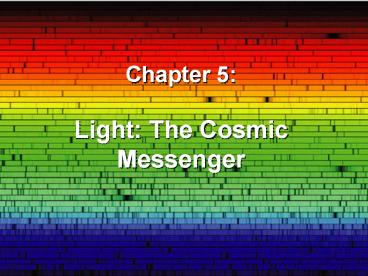Chapter 5: Light: The Cosmic Messenger - PowerPoint PPT Presentation
1 / 27
Title:
Chapter 5: Light: The Cosmic Messenger
Description:
Title: Chapter 6: Light: The Cosmic Messenger Author: John Johnson Last modified by: lisa lrobards Created Date: 9/21/2004 8:52:06 PM Document presentation format – PowerPoint PPT presentation
Number of Views:144
Avg rating:3.0/5.0
Title: Chapter 5: Light: The Cosmic Messenger
1
Chapter 5Light The Cosmic Messenger
2
What is Light?
- Light is radiative energy
- Energy is measured in Joules
- Power is measured in Watts 1 watt 1 joule/s
- The power a person uses in a day is about 10
Mjoules, equivalent to leaving a 100W bulb on all
day
3
How Light Behaves
- Emission
- Absorption
- Transmission
- Reflection
4
(No Transcript)
5
If you pass white light through a prism, it
separates into its component colors.
R.O.Y. G. B.I.V
spectrum
6
Duality of Light
- Light can behave as a particle and a wave
- In the 17th Century, Isaac Newton argued that
light was composed of little particles while
Christian Huygens suggested that light travels in
the form of waves. - In the 19th Century, Thomas Young demonstrated
that light bends slightly around corners and acts
like interfering waves.
7
Thomas Youngs interference experiment
8
Scottish physicist James Clerk Maxwell showed
mathematically in the 1860s that light must be a
combination of electric and magnetic fields.
9
Light and Energy
- Photon energy Planks constant x speed of light
/ wavelength E h x f hc/? - As Energy goes up, frequency goes up, wavelength
gets smaller
10
Peak color (wavelength) shifts to shorter
wavelengths as an objects is heated
11
Peak color (wavelength) emitted depends on an
objects temperature
12
Peak color (wavelength) shifts to shorter
wavelengths as an objects is heated
13
The intensities of different emitted colors
reveal a stars temperature
- Wiens Law
- Wavelength is inversely proportional to
temperature - lmax (2.9 x 10-3) / TKelvin
- As Energy goes up, Temperature increases and
wavelength gets smaller, and frequency gets
greater
14
What color is our 5800K Sun?
- The Sun emits all colors (wavelengths of
electromagnetic radiation) however, the colors
it emits most intensely are in the blue-green
part of the spectrum.
15
(No Transcript)
16
Each chemical element produces its own unique set
of spectral lines when it burns
17
The Suns Spectrum
18
The brightness of spectral lines depend on
conditions in the spectrums source
- Law 1 A hot object or a hot, dense gas produces
a continuous spectrum -- a complete rainbow of
colors with without any specific spectral lines.
(This is a black body spectrum.) - Law 2 A hot, rarefied gas produces an emission
line spectrum - a series of bright spectral lines
against a dark background. - Law 3 A cool gas in front of a continuous source
of light produces an absorption line spectrum - a
series of dark spectral lines among the colors of
the rainbow.
19
Absorption Spectrum of Hydrogen Gas
20
Kirchhoffs Laws
21
Spectral lines occur when an electron jumps from
one energy level to another
22
(No Transcript)
23
We can determine a stars movement by observing
the shift in spectrum of the light from a star
- Barnards Star
24
Spectral lines shift due to the relative motion
between the source and the observer
25
Doppler Shifts
- Red Shift The distance between the observer and
the source is increasing - Blue Shift The distance between the observer and
the source is decreasing
26
The Doppler shift allows astronomers to measure
radial velocity
27
What can we learn by analyzing starlight?
- A stars temperature
- by peak wavelength
- A stars chemical composition
- by spectral analysis
- A stars radial velocity
- from Doppler shifts































